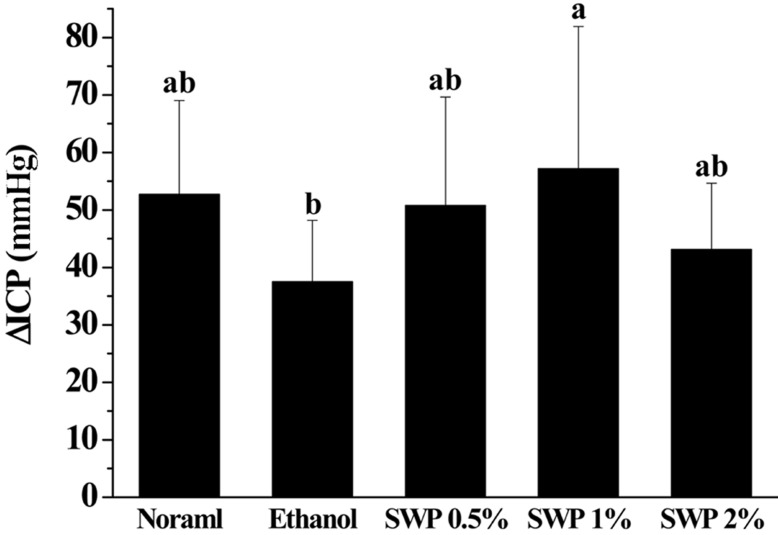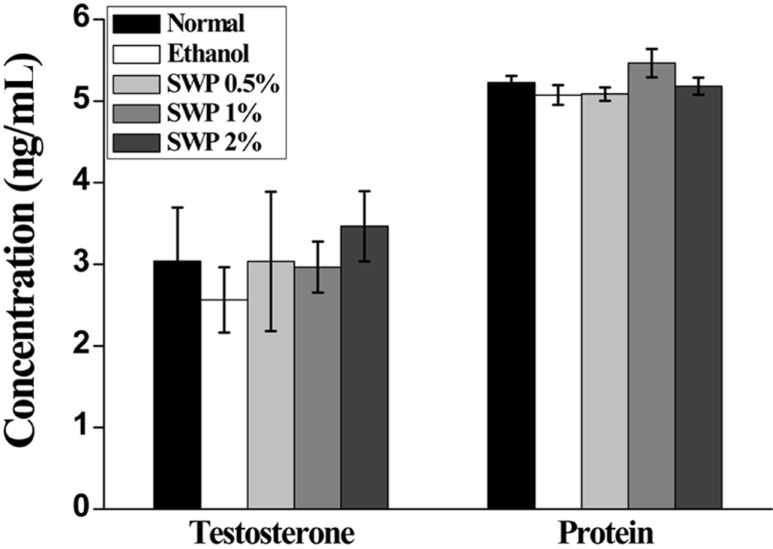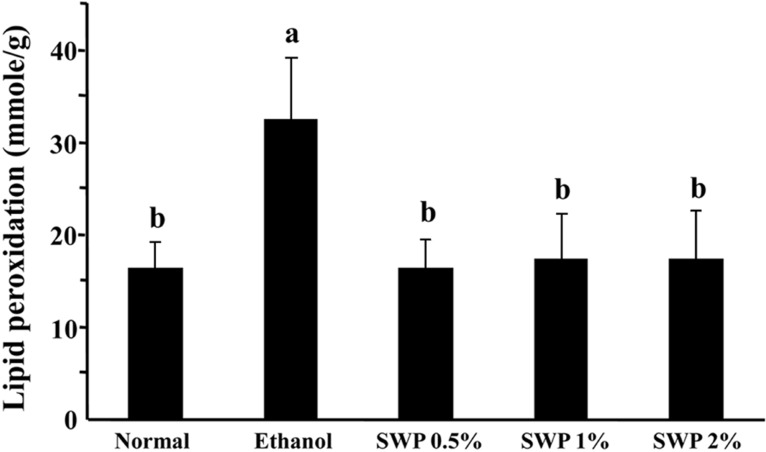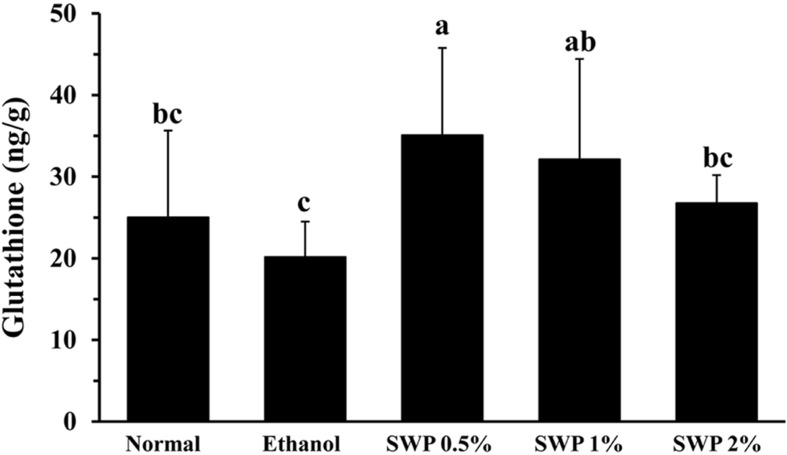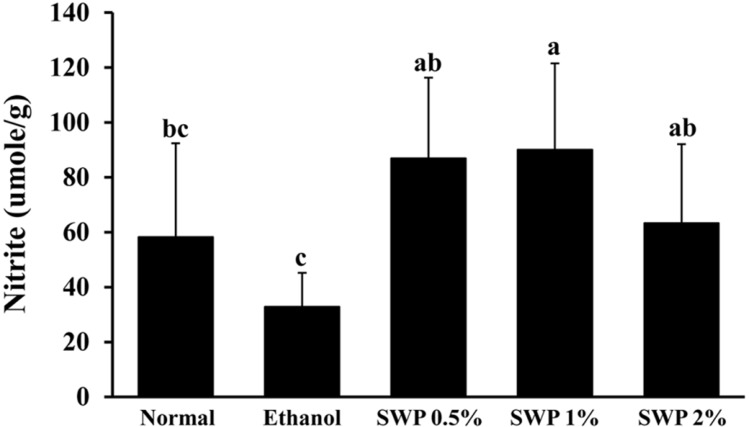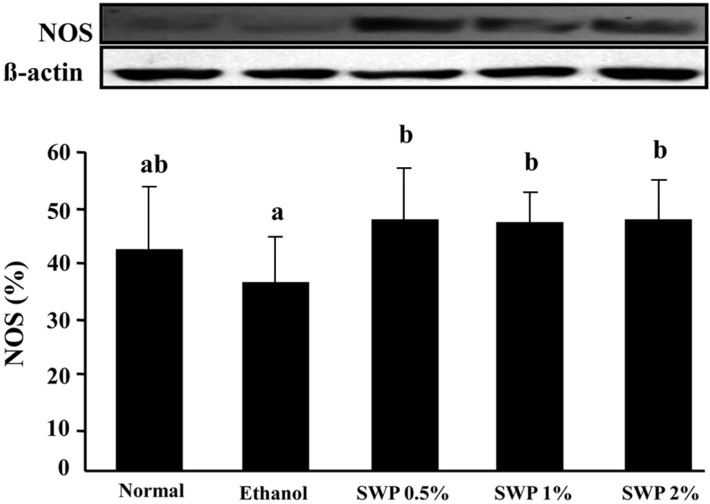Abstract
Erectile dysfunction (ED) is a highly prevalent disorder that affects millions of men worldwide. ED is now considered an early manifestation of atherosclerosis, and consequently, a precursor of systemic vascular disease. This study was designed to investigate the effects of male silkworm pupa powder (SWP) on the levels of nitric oxide synthase (NOS) expression, nitrite, and glutathione (GSH); lipid peroxidation; libido; and erectile response of the corpus cavernosum of the rat penis. We induced ED in the study animals by oral administration of 20% ethanol over 8 weeks. The SWP-treated male rats were divided into 3 groups that were orally administered 200, 400, and 800 mg/kg. The libido of the SWP-administered male rats was higher than that of the ethanol control group. In addition, the erectile response of the corpus cavernosum was restored in males on SWP administration, to a level similar to that of the normal group without ED. The testosterone concentration did not increase significantly. The lipid peroxidation in the corpus cavernosum of the male rats administered SWP decreased significantly. In contrast, compared to the ethanol group, SWP-administered male rats showed increased GSH levels in the corpus cavernosum. The level of nitrite and NOS expression in the corpus cavernosum of SWP-administered male rats increased significantly. These results indicated that SWP effectively restored ethanol-induced ED in male rats.
Keywords: Erectile dysfunction, libido activity, sexual function, silkworm pupa powder
Erectile dysfunction (ED) is defined as the inability to attain or maintain a penile erection for satisfactory sexual performance. ED can be triggered by psychological and physiological causes. Physiological causes include neurological, hormonal, and vascular pathologies as well as traumatic and iatrogenic factors or a combination of these factors [1]. Neurological factors include brain tumor, cerebrovascular disease, spinal cord injury, diabetes mellitus, and alcoholism [2]. Previous research showed that ethanol inhibits normal erectile function and reduces sperm count with an irreversible prostate atrophy [3]. The process of achieving a penile erection involves the integration of psychological, neurological, and vascular processes, which combine to initiate a physiological response within the penile vasculature. The dilation of smooth muscles (SMs) results in increased blood flow into the sinusoids of the corpora cavernosum. The corpora cavernosum subsequently fills, which obstructs the venous outflow from the penis by compression of the veins against the tunica albuginea, resulting in penile erection [4].
Corpus cavernous SM relaxation is induced by neurotransmitters and endothelium-derived factors [5,6]. Prostaglandin and endothelium-derived relaxing factor (EDRF) play a role in penile erection by controlling the cavernous SM relaxation [7]. The identification of nitric oxide (NO) as EDRF was independently demonstrated by Furchgott and by Ignarro in the mid-1980s [8,9]. Endothelium-derived NO, formed by endothelial nitric oxide synthase isoform 3 (NOS3) by genomic and nongenomic mechanisms as well as a variety of posttranslational modifications such as phosphorylation [10], is not only a vasodilator but also an inhibitor of cell growth and inflammation [11,12]. Many studies have shown that NO is a strong EDRF, and endothelial dysfunction and impaired NO production are important in ED [13,14]. NO synthase (NOS)-containing nerve fibers associated with penile arteries and cavernous tissues, and the endothelium lining the sinusoids are the NO sources responsible for relaxation and subsequent penile erection [15].
Silkworm pupae protein, which contains 18 amino acids, is a good source of high-quality protein. According to the Food and Agriculture Organization (FAO) and the World Health Organization (WHO), silkworm pupae protein is a good nutritional source [16-18]. The main constituents of silkworm pupae extracts contained more than 68% total unsaturated fatty acids and 27.99% alpha-linolenic acid [19] Male silkworm pupa powder (SWP) is known to be effective in enhancing male stamina and improving vitality [20]. Crude insect drugs used in Oriental medicine, and unmated male silkworm moths are used to treat ED. Silkworm larvae and pupae are currently registered as food sources, and 14 days after metamorphosis, the pupae can be substituted for the silkworm moth with the same efficacy [20]. However, the main component responsible for the improvement of ED dysfunction symptoms and the detailed mechanism of this improvement remain unclear.
The aim of this study was to evaluate the effectiveness of SWP used for ED in an animal model. To study the effect of SWP administration on ethanol-induced ED in male rats, we monitored their sexual behavior and measured the intracavernous peak pressure and velocity as well as the NOS expression, nitrite level, canvernosal glutathione (GSH) level, lipid peroxidation, testosterone level, and protein level.
Materials and Methods
Materials
We used the powder of male silkworm (Bombyx mori) pupae provided by the Rural Development Administration (Suwon, Korea). The greenish-brown powder was obtained by freeze-drying of non-mating Yangwonjam.
Animals
Forty male Sprague-Dawley (SD) rats (7 weeks old) and 20 female SD rats (7 weeks old), specific and pathogen-free animals were used in these studies and were obtained from Orient Inc. (Seongnam, Korea). All procedures were approved by the Animal Ethics Committee in Wonkwang University (Approval No. WKU 10-027).
Animal model for ED and oral administration
Forty male rats were randomly divided into 5 groups: normal, ethanol, low-dose (0.5% SWP), medium-dose (1% SWP), and high-dose (2% SWP). After a week of acclimation, the normal group was fed standard chow without SWP and water sterilized by ultraviolet radiation and filtration. After pulverization of solid food purchased from Samtaco Co. (Osan, Korea) in Wonkwang Mill (Jeonju, Korea), we mixed the food with 0%, 0.5%, 1.0%, or 2.0% SWP. The mixed feed was used during the experimental period. All of the 40 rats, except for the rats comprising the normal group, were provided water containing 20% ethanol for 8 weeks [21].
During the 20% ethanol treatment, the ethanol group consumed general feed containing no SWP. SWP contents of 0.5, 1.0, and 2.0% were orally administered to the low-, medium-, and high-dose groups, respectively. We measured the average eating rate of the normal feed mixture during the week after the administration of SWP.
Behavioral test: contact (mating) test
Twenty female SD rats (8 weeks old) were used for the mating test after a week of acclimation. The female rats were subjected to ovariohysterectomy to synchronize the estrous phase. Rats were subjected to ovariohysterectomy under general anesthesia by intraperitoneal injection of ketamine (50mg/mL; Ketamine, Yuhan Co., Seoul, Korea) and xylazine (20 mg/mL; Rumpoon, Byer Aimal Health Co., Suwon, Korea) in a ratio of 4:1 according to the technique described by Shinoda and colleagues [22]. The estrous phase in the females with ovariohysterectomy was induced by subcutaneous injection of a corn-oil solution of 10 µg of estradiol benzoate (Samyang Anipharm, Seoul, Korea) 48 h before the test and 2 mg of progesterone (Samyang Anipharm, Seoul, Korea) 4-5 h before the test. Behavioral testing was performed under dim red light illumination in the middle part of the dark phase of the light-dark cycle. To avoid subjectivity when determining sexual function, 4 researchers observed the behavior of the rats each time, and video recordings of these tests were analyzed to determine the frequency of mounts, intromissions, and ejaculations shown by the experimental males. According to the experimental groups, male rats were placed in a cage in which females had been adapted for 5 min. The experiment was conducted 3 times at intervals of 3 days, and the experiments were always started at noon. The tests lasted 45 min to observe the intromission and ejaculation; we concluded that a sexual behavior occurred when we could ascertain that the ejaculation had occurred >2 times.
Measurement of erectile responses
Experimental animals were anesthetized with a 1:7 mixture of xylazine (23.3 mg/mL) and ketamine (57.68 mg/mL) (0.4 mL/250 g) by intraperitoneal injection and were maintained under anesthesia with phenobarbital (Ruminal, Daihan Pharm Co., Ltd, Seoul, Korea) by intramuscular injection; this treatment had no effect on the blood pressure. The ventrodorsally positioned carotid artery of the animals was exposed and connected to Polyethylene 50 (Dow Corning, Midland, MO, USA) filled with heparinized saline (100 IU/mL). The silicone tube was connected to channel 1 of the pressure transducer (MLT1199BP Transducer, ADInstruments, Colorado Springs, CO, USA). The right major pelvic ganglion was exposed by a low abdominal midline incision, and the corpus cavernous nerve on either side of the prostate was isolated through a skin incision overlying the penis. A bipolar platinum electrode and Stimulator HC (ML155, ADInstruments) were used to directly stimulate the right cavernous nerve. Next, the right base of the penis was exposed, and the right corporal body was cannulated with a 22-gauge needle primed with 100 U/mL heparin-saline and connected to channel 2 of the pressure transducer (MLT1199BP Transducer, ADInstruments). The electrostimulation was controlled with an amplifier (Podbridge, ADInstruments) connected to a data acquisition system (ML846 Powerlab 4/26, ADInstruments). The intracavernous pressure (ICP) was recorded and analyzed using a data analysis software (Powerlab Program, ADInstruments). The average maximum ICP was recorded.
Enzyme preparation
After the erectile response test, blood samples were harvested from the abdominal vein and the corpus cavernosum tissue of the penis. The blood and foreign bodies in the corpus cavernosum tissues were removed by washing with saline. The corpus cavernosum was isolated from all rats and was homogenized using Ultra-Turrax (IKA T10 basic; IKA Laboratory Equipment, Staufen GmbH & Co., Germany) in 4 mL/g 0.1M potassium phosphate (pH 7.4). After centrifugation at 10,000 g at 4℃ for 10 min, the lipid peroxidation and nitrite level in the supernatant were measured. After a second centrifugation step at 8,000 g for 30 min, the supernatant was used for the source of NOS.
Measurement of the GSH level
The GSH level in the corpus cavernosum tissue of the penis was measured using a GSH detection kit according to the manufacturer's specifications (ApoGSH™ Glutathione Colorimetric Detection Kit, BioVision, Mountain View, CA, USA). The corpus cavernosum tissue (0.1 g) was homogenized in 0.4 mL of GSH buffer, and 5% sulfosalicylic acid solution was then added. The homogenized buffer solution was centrifuged at 8000 g for 10 min, and the GSH level was then measured in the supernatant by monitoring the absorbance at 405 nm using spectrometry. Results were expressed in nanograms per gram of tissue based on a standard curve.
Measurement of the lipid peroxidation level
A lipid peroxidation kit (LPO Assay Kit, Oxford Biomedical Research, Rochester Hills, MI, USA) was used to measure the lipid peroxidation level in the corpus cavernosum tissue of the penis. After the tissues had been dissolved in 140 mL of acetonitrile, 455 mL of N-methyl-2-phenylindole solution was added. The 105-mL mixture of methane sulfonic acid and 4-hydroxyalkenals was incubated at 45℃ for 1 h. The sample was then centrifuged at 15000 g for 10 min, and the absorbance was measured at 586 nm by spectrometry. Results were expressed in millimoles per gram of tissue based on a standard curve.
Measurement of the nitrite level
To measure the nitrite level in the corpus cavernosum tissue of the penis, we used a nitric oxide detection kit (Intron biotechnology, Sungnam, Korea) that is based on colorimetry using the Griess reaction. The method was performed, and the results were analyzed according to manufacturer's protocol. Briefly, 50mL of the sulfanilamide solution was added to 100 mL of the tissue-derived supernatant in a 96-well plate. The mixture was incubated at room temperature for 5 min. Naphthylenediamine (50 ml) was then added to each well, the plate was incubated for 5 min, and the sample absorbance was measured at 550 nm by spectrometry. The standard curve was determined by measuring the absorbance of 0.98-1,000 µM nitrite standards, and the results were expressed as µM nitrite per gram of tissue.
Measurement of the changes in the epithelial NOS level by western blotting
The protein level in the corpus cavernosum tissue of the penis was measured using the Protein Quantification Kit (Dojindo Laboratory, Kumamoto, Japan). Proteins (20 µg/sample) were separated by 10% polyacrylamide gel electrophoresis and then transferred onto a Hybond™-PVDF membrane (Amersham International Plc., Little Chalfont, Buckinghamshire, UK). Chemiluminescence was detected using Enhanced Chemiluminescence western blotting detection reagents (Amersham International Plc.) according to the manufacturer's protocol.
Measurement of the testosterone and protein levels in the blood
The protein and testosterone levels in the blood were measured using Lowry's method with bovine serum albumin and a chemiluminescence immunoassay kit (Amersham International Plc.), respectively [2].
Statistical analysis
Statistical analysis of the data was performed by oneway analysis of variance (ANOVA) followed by the Duncan test for multiple comparisons. P-values less than or equal to 0.05 were considered statistically significant.
Results
Effect of SWP on direct sexual behavior
Sexual behavior was evaluated as the total positive libido response of each group; thus, a standard deviation could not be measured (Table 1). The number of normal sexual functions performed by the ethanol group (2 sexual functions) showed that ethanol-induced ED resulted in a decreased sexual function compared with the normal group (4 sexual functions). The SWP 0.5% group showed 3 times improved sexual response numbers than the ethanol group. In addition, both the SWP 1% and SWP 2% groups showed greater sexual response numbers than the ethanol group, but they showed the same number compared to the normal group. Direct sexual behavior, as measured by the libido test, showed a gradual increase in the SWP groups compared with the ethanol group.
Table 1.
Effects of the silkworm puea powder (SWP) on libido test in erectile dysfunction models induced by ethanol
Data are shown as mean (n=8).
Effect of SWP on the erectile response
The erectile response was assessed in all rats by measuring the ICP. The ICP of the ethanol group decreased compared with the normal group (52.72±16.31 mmHg and 37.50±10.70 mmHg, respectively) (Figure 1). SWP administration (the 0.5, 1, and 2% groups) resulted in increased ICP values. Importantly, the ICP of the SWP 1% group was significantly higher than that of the ethanol group. However, the ICP change was not dose-dependent; 57.15±24.80 and 43.11±11.57 mmHg in the SWP 0.5 and SWP 1% groups, respectively.
Figure 1.
Effect of the silkworm pupa powder (SWP) on the erectile response to carvernous nerve stimulation in chronic ethanol-treated rats. a,bValues in the row with different superscripts are significantly different, P<0.05. Data are shown as the mean±SD (n=8).
Effect of SWP on the serum testosterone and protein concentrations
Although the serum testosterone level did not change significantly, a slight decrease was observed in the ethanol group compared with the normal group. The hormone level in the SWP groups was similar to or higher than that observed in the normal group (Figure 2). We could not observe any significant changes in the protein level in the different groups.
Figure 2.
Effect of the silkworm pupa powder (SWP) on the blood testosterone and protein level in chronic ethanol-treated rats. Data are shown as the mean±SD (n=8).
Effect of SWP on the lipid peroxidation level
Although the lipid peroxidation level in the corpus cavernous tissue of the penis significantly increased in the ethanol group, the lipid peroxidation level decreased in the experimental groups that had been administered SWP (Figure 3). This decrease was independent of the concentration of SWP.
Figure 3.
Effect of the silkworm pupa powder (SWP) on the lipid peroxidation level in corpus cavernosum of chronic ethanol-treated rats. a,bValues in the row with different superscripts are significantly different, P<0.05. Data are shown as the mean±SD (n=8).
Effect of SWP on the GSH level
SWP influenced the GSH level in the corpus cavernous tissue (Figure 4). In the ethanol group, the GSH level was 20.16±4.34 ng/g, which was significantly lower than the GSH level in the normal group (25.01±10.64 ng/g). The GSH level increased significantly in the SWP-treated groups (SWP 0.5, 1, and 2%; 35.08±10.07, 32.12±3.41, and 26.78±13.27 ng/g, respectively) compared with the ethanol group.
Figure 4.
Effect of the silkworm pupa powder (SWP) on the glutathione level in corpus cavernosum of chronic ethanol-treated rats. a,b,cValues in the row with different superscripts are significantly different, P<0.05. Data are shown as mean±SD (n=8).
Effect of SWP on the nitrite concentration
Because nitrite is the most important neurotransmitter mediating the relaxation of the SM layer present in the corpus cavernosum, we measured the nitrite concentration (Figure 5). In the corpus cavernosum, the nitrite level decreased significantly after the alcohol treatment, and the nitrite level increased in the SWP 0.5, 1, and 2% groups (86.90±29.44, 90.09±31.42, and 63.27±28.82 ng/g, respectively) compared with the ethanol group (32.85±12.34 µM/g). In addition, although the nitrite level was higher in all of the experimental groups compared with the normal group, this higher level was independent of the amount of SWP administered.
Figure 5.
Effect of the silkworm pupa powder (SWP) on the nitrite level in corpus cavernosum of chronic ethanol-treated rats. a,b,cValues in the row with different superscripts are significantly different, P<0.05. Data are shown as the mean±SD (n=8).
Effect of SWP on the NOS expression
Because NO is synthesized via NOS catalysis, we measured the NOS content in the corpus cavernosum (Figure 6). In all experimental groups, the expression of NOS against actin differed; thus, we obtained a correction factor to compare the expression of NOS. After 8 weeks of alcohol exposure, the NOS expression level decreased significantly in the corpus cavernosum tissue. The NOS level significantly increased in the SWP 0.5, 1, and 2% groups (45.63±8.99, 44.63±5.78, and 45.50±7.09%, respectively) compared with the ethanol group (33.88±8.34%); however, this decrease was independent of the amount of SWP administered.
Figure 6.
Effect of the silkworm pupa powder (SWP) on the nitric oxide synthase (NOS) in corpus cavernosum of chronic ethanol-treated rats. a,bValues in the row with different superscripts are significantly different, P<0.05. Data are shown as the mean±SD (n=8).
Discussion
ED can be triggered by psychological and physiological causes. Physiological causes include neurological, hormonal, and vascular pathologies as well as traumatic and iatrogenic factors, or combinations of these factors [1]. Hormonal factors include hypogonadism caused by pituitary gland tumor, hyperprolactinemia, hyperthyroidism, hypothyroidism, and Cushing's syndrome [2]. In addition, vascular factors that lead to ED are associated with certain medical conditions, including diabetes, renal disease, hypertension, heart disease, hepatocirrhosis, and aging [2]. Previous research showed that ethanol significantly inhibits normal erectile function [23,24] and causes reduced sperm count with irreversible prostate and seminiferous tubule atrophy in alcoholics [3].
We used SWP derived from freeze dehydration to evaluate the effect of SWP on erectile function. Differences in sexual behavior were observed depending on the sexual health of the male rats in the ED study. Repeat observation, enabled by videography, is important because there are no standardized methods for assessing sexual function and copulation of male rats [25].
After administration of SWP for 8 weeks, the SWP group had more mating frequencies than the ethanol group (Table 1).
The process of achieving penile erection involves the integration of psychological, neurological, and vascular processes that combine to initiate a physiologic response within the penile vasculature. Endothelial-mediated dilation of the arteriolar SM results in increased blood flow into the sinusoids of the corpora cavernosum. The sinusoids subsequent fill while simultaneously relaxing to increase compliance. The filling obstructs the venous outflow from the penis by compressing the veins against the tunica albuginea, resulting in penile erection [4]. Our study supports that penile erection, the most important factor of sexual function, is related to the blood pressure of the corpora cavernosum of the penis. The male rats administered 20% ethanol for 8 weeks had a significantly lower blood pressure in the corpora cavernosum of the penis compared with the normal group. In contrast, the blood pressure of the experimental group, administered SWP after feeding on 20% ethanol, increased to a level similar to that of the normal group (Figure 1).
Pupae powder possesses a tonic effect that increases the testosterone level in the serum by 19% after 3-week repeat treatments [20]. However, we could not observe significant changes to the testosterone level in the SWP-administered group (Figure 2). Defensive mechanisms include enzyme-mediated processes, including superoxide dismutase (SOD), catalase, and glutathione peroxidase catalysis, as well as non-enzymatic processes such as antioxidant action by vitamin E, vitamin C, β-carotene, and GSH, which remove active oxygen species in the body [26-28]. Synthesized within the liver and systemically distributed, GSH removes active oxygen species [29]. In our study, the GSH concentration in the ethanol group (fed ethanol for 8 weeks) significantly decreased; however, the GSH concentration increased to the level of the normal group after administering SWP (Figure 4). This result suggested that GSH is active during oxygen stress and is involved in protecting against cellular toxicity in the penis; thus, GSH helped improve sexual function. In addition, lipid peroxidation, which occurs in a biochemical chain reaction using active oxygen species, exacerbates cellular damage. Oxidized lipids are endogenous toxic materials because they disrupt the cellular membrane [30]. We also measured the lipid peroxidation level in the penis of rats administered SWP for 8 weeks (Figure 3). After administering SWP for 8 weeks, the lipid peroxidation level, which had been increased by ethanol feeding, decreased to the level of the normal group.
In our present work, SWP had antioxidant effects that decreased lipid peroxidation and inhibited cellular damage in the penis. This effect could improve physiological erectile function and prevent sexual dysfunction.
NO is the most important neurotransmitter, mediating relaxation of the SM layer of the corpus cavernosum. Synthesized within the vascular endothelium by NOS, NO is an endothelium-derived relaxation factor. NO diffuses through the cell membrane and activates guanylate cyclase in the SM in the vessel and the adjacent corpus cavernosum [31]. Consequently, NO increases the synthesis of cyclic guanosine monophosphate, mediating the relaxation of the corpus cavernosum. Constitutive endothelial NOS and inducible NOS are located in the vascular endothelium [15]. In this study, we showed that the group administered SWP for 8 weeks had a significantly increased NOS expression and nitrite levels compared with the normal group (Figures 5 and 6). Alcohol-induced ED can thus be prevented by SWP treatment, which activates NOS in the penile tissue and increases the biosynthesis of NO, the causative factor of ED.
This study reports the effect of SWP on ED in a rat model. Our findings implicate a multifactorial role of SWP. The antioxidative activity of SWP may defend penile cells against active oxygen species, decrease the fatigue of the penile tissue, and enhance erectile function. In conclusion, SWP may be useful as a preventive or therapeutic material to counteract alcohol-induced ED symptoms.
Acknowledgments
The Work Described In This Paper Was Supported By An Agenda Grant From The Rural Development Administration, Korea, 2010.
References
- 1.Maas R, Schwedhelm E, Albsmeier J, Boger RH. The pathophysiology of erectile dysfunction related to endothelial dysfunction and mediators of vascular function. Vasc Med. 2002;7(3):213–225. doi: 10.1191/1358863x02vm429ra. [DOI] [PubMed] [Google Scholar]
- 2.Benet AE, Melman A. The epidemiology of erectile dysfunction. Urol Clin North Am. 1995;22(4):699–709. [PubMed] [Google Scholar]
- 3.Cheng JY, Ng EM, Chen RY, Ko JS. Alcohol consumption and erectile dysfunction: meta-analysis of population-based studies. Int J Impot Res. 2007;19(4):343–352. doi: 10.1038/sj.ijir.3901556. [DOI] [PubMed] [Google Scholar]
- 4.Christ GJ. The penis as a vascular organ. The importance of corporal smooth muscle tone in the control of erection. Urol Clin North Am. 1995;22(4):727–745. [PubMed] [Google Scholar]
- 5.Hedlund H, Andersson KE. Contraction and relaxation induced by some prostanoids in isolated human penile erectile tissue and cavernous artery. J Urol. 1985;134(6):1245–1250. doi: 10.1016/s0022-5347(17)47704-4. [DOI] [PubMed] [Google Scholar]
- 6.Saenz de Tejada I, Blanco R, Goldstein I, Azadzoi K, de las Morenas A, Krane RJ, Cohen RA. Cholinergic neurotransmission in human corpus cavernosum. I. Responses of isolated tissue. Am J Physiol. 1988;254(3):H459–H467. doi: 10.1152/ajpheart.1988.254.3.H459. [DOI] [PubMed] [Google Scholar]
- 7.Saenz de Tejada I, Goldstein I, Azadzoi K, Krane RJ, Cohen RA. Impaired neurogenic and endothelium-mediated relaxation of penile smooth muscle from diabetic men with impotence. N Engl J Med. 1989;320(16):1025–1030. doi: 10.1056/NEJM198904203201601. [DOI] [PubMed] [Google Scholar]
- 8.Furchgott RF. Introduction to EDRF research. J Cardiovasc Pharmacol. 1993;22(Suppl 7):S1–S2. [PubMed] [Google Scholar]
- 9.Ignarro LJ, Buga GM, Wood KS, Byrns RE, Chaudhuri G. Endothelium-derived relaxing factor produced and released from artery and vein is nitric oxide. Proc Natl Acad Sci USA. 1987;84(24):9265–9269. doi: 10.1073/pnas.84.24.9265. [DOI] [PMC free article] [PubMed] [Google Scholar]
- 10.Forstermann U, Munzel T. Endothelial nitric oxide synthase in vascular disease: from marvel to menace. Circulation. 2006;113(13):1708–1714. doi: 10.1161/CIRCULATIONAHA.105.602532. [DOI] [PubMed] [Google Scholar]
- 11.Garg UC, Hassid A. Nitric oxide-generating vasodilators and 8-bromo-cyclic guanosine monophosphate inhibit mitogenesis and proliferation of cultured rat vascular smooth muscle cells. J Clin Invest. 1989;83(5):1774–1777. doi: 10.1172/JCI114081. [DOI] [PMC free article] [PubMed] [Google Scholar]
- 12.Ross R. Atherosclerosis--an inflammatory disease. N Engl J Med. 1999;340(2):115–126. doi: 10.1056/NEJM199901143400207. [DOI] [PubMed] [Google Scholar]
- 13.Palmer RM, Ashton DS, Moncada S. Vascular endothelial cells synthesize nitric oxide from L-arginine. Nature. 1988;333(6174):664–666. doi: 10.1038/333664a0. [DOI] [PubMed] [Google Scholar]
- 14.Rajfer J, Aronson WJ, Bush PA, Dorey FJ, Ignarro LJ. Nitric oxide as a mediator of relaxation of the corpus cavernosum in response to nonadrenergic, noncholinergic neurotransmission. N Engl J Med. 1992;326(2):90–94. doi: 10.1056/NEJM199201093260203. [DOI] [PubMed] [Google Scholar]
- 15.Bredt DS, Ferris CD, Snyder SH. Nitric oxide synthase regulatory sites. Phosphorylation by cyclic AMP-dependent protein kinase, protein kinase C, and calcium/calmodulin protein kinase; identification of flavin and calmodulin binding sites. J Biol Chem. 1992;267(16):10976–10981. [PubMed] [Google Scholar]
- 16.Singh KC, Suryanarayna N. Eri pupae: A popular cuisine too. Indian Silk. 2003;41:57–58. [Google Scholar]
- 17.Zhou J, Han DX. Proximate, amino acid and mineral composition of pupae of the silkworm Antheraea pernyi in China. J Food Compos Anal. 2006;19:850–853. [Google Scholar]
- 18.Usub T, Lertsatitthanakorn C, Poomsa-ad N, Wiset L, Yang LF, Siriamornpun S. Experimental performance of a solar tunnel dryer for drying silkworm pupae. Biosyst Eng. 2008;101:209–216. [Google Scholar]
- 19.Wei ZJ, Liao AM, Zhang HX, Liu J, Jiang ST. Optimization of supercritical carbon dioxide extraction of silkworm pupal oil applying the response surface methodology. Bioresour Technol. 2009;100:4214–4219. doi: 10.1016/j.biortech.2009.04.010. [DOI] [PubMed] [Google Scholar]
- 20.Ryu KS, Ahn MY, Lee HS, Kim IK, Kim JW, Kim SH, Choi JH. The tonic effect of the extract from male silkworm (Bombyx mori L.) pupae on rats. Int J Indust Entomol. 2002;5(1):123–126. [Google Scholar]
- 21.Tirapelli CR, Fukada SY, Yogi A, Chignalia AZ, Tostes RC, Bonaventura D, Lanchote VL, Cunha FQ, de Oliveira AM. Gender-specific vascular effects elicited by chronic ethanol consumption in rats: a role for inducible nitric oxide synthase. Br J Pharmacol. 2008;153(3):468–479. doi: 10.1038/sj.bjp.0707589. [DOI] [PMC free article] [PubMed] [Google Scholar]
- 22.Shinoda M, Latour MG, Lavoie JM. Effects of physical training on body composition and organ weights in ovariectomized and hyperestrogenic rats. Int J Obes Relat Metab Disord. 2002;26(3):335–343. doi: 10.1038/sj.ijo.0801900. [DOI] [PubMed] [Google Scholar]
- 23.Fung MM, Bettencourt R, Barrett-Connor E. Heart disease risk factors predict erectile dysfunction 25 years later: the Rancho Bernardo Study. J Am Coll Cardiol. 2004;43(8):1405–1411. doi: 10.1016/j.jacc.2003.11.041. [DOI] [PubMed] [Google Scholar]
- 24.Luc TF. Erectile dysfunction. N Engl J Med. 2000;342(24):1802–1813. doi: 10.1056/NEJM200006153422407. [DOI] [PubMed] [Google Scholar]
- 25.Fridovich I. Superoxide dismutases. Annu Rev Biochem. 1975;44:147–159. doi: 10.1146/annurev.bi.44.070175.001051. [DOI] [PubMed] [Google Scholar]
- 26.Kono Y, Fridovich I. Superoxide radical inhibits catalase. J Biol Chem. 1982;257(10):5751–5754. [PubMed] [Google Scholar]
- 27.Halliwell B, Gutteridge JM. Oxygen toxicity, oxygen radicals, transition metals and disease. Biochem J. 1984;219(1):1–14. doi: 10.1042/bj2190001. [DOI] [PMC free article] [PubMed] [Google Scholar]
- 28.Bendich A, D'Apolito P, Gabriel E, Machlin LJ. Interaction of dietary vitamin C and vitamin E on guinea pig immune responses to mitogens. J Nutr. 1984;114(9):1588–1593. doi: 10.1093/jn/114.9.1588. [DOI] [PubMed] [Google Scholar]
- 29.Ross D. Glutathione, free radicals and chemotherapeutic agents. Mechanisms of free-radical induced toxicity and glutathione-dependent protection. Pharmacol Ther. 1988;37(2):231–249. doi: 10.1016/0163-7258(88)90027-7. [DOI] [PubMed] [Google Scholar]
- 30.Hornsby PJ, Crivello JF. The role of lipid peroxidation and biological antioxidants in the function of the adrenal cortex. Part 2. Mol Cell Endocrinol. 1983;30(2):123–147. doi: 10.1016/0303-7207(83)90043-6. [DOI] [PubMed] [Google Scholar]
- 31.Furchegott RF. Role of endothelium in response of vascular smooth muscle. Circ Res. 1983;53(5):557–573. doi: 10.1161/01.res.53.5.557. [DOI] [PubMed] [Google Scholar]




